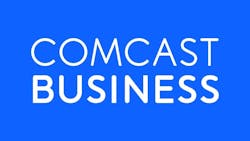Comcast Business extends Dedicated Internet Access (DIA) to 1M new businesses
Here’s more coverage of other key stories on Ethernet and business services:
- AT&T continues its U.S. Ethernet dominance
- Lumen is driving network expansion to build the backbone of the AI economy
- Comcast Business’ revenue base is approaching $10 billion.
- Comcast Business’ Nitel acquisition enhances its managed networking capabilities
- VMware takes over the top spot from Cisco on VSG’s SD-WAN technology LEADERBOARD
Comcast Business is expanding its Dedicated Internet solution to 1 million new business locations, threatening incumbent Ethernet providers like AT&T and Lumen, which have long enjoyed dominant positions in the business services market.
The service provider said the move is part of a broader $80 billion investment in network innovation over the last decade to satisfy business customers' needs for DIA services.
A key element of the DIA service drive is its focus on delivering symmetrical speeds with SLAs, whether over fiber or its existing HFC cable network.
Comcast Business is stepping up network monitoring in tandem with symmetrical speeds. Business customers can access enhanced symmetrical speeds – up to 200 Mbps over HFC and 400 Gbps over fiber.
The cable MSO is leveraging AI and cloud to proactively manage network performance, addressing potential issues before they impact customers. These enhancements extend to Comcast Business’s entire portfolio of Ethernet Transport solutions and allow it to bring new capabilities to more businesses.
Christian Nascimento, Senior Vice President of Connectivity and Digital Customer Solutions at Comcast Business, said the company plans to expand Dedicated Internet to over three times as many additional businesses in the coming year.
“Our expansion of Dedicated Internet Access (DIA) is part of Comcast Business’s growth story,” he said. “These businesses need DIA. There are a lot of applications businesses use and digital transformation, which is all being driven by the need not just for bandwidth, but also for a dedicated line and the service level agreements (SLA).”
He added that Comcast Business is scaling its DIA service more rapidly because it leverages the parent company's ongoing investments in upgrading its existing HFC and fiber infrastructure.
“What this effort is expanding our reach to businesses with a muscular version of DIA, whether on fiber or HFC plant by leveraging all the technological advances around its network, including our network upgrades around mid-splits,” Nascimento said. “By giving our customers the option of getting DIA on fiber or HFC with the same SLA, we provide them with the ability to install the service faster.”
Enhancing on-net fiber reach
Comcast will enhance its fiber connections to more business buildings to meet this demand.
Cable providers continue to scale their on-net fiber reach overall.
According to Vertical Systems Group’s year-end 2023 U.S. Fiber Lit Buildings LEADERBOARD, cable providers significantly grew in net new fiber lit commercial buildings during 2023.
Comcast Business took over the fourth position then, displacing Lumen, which dipped to fifth overall. Lumen lost a share in the on-net fiber segment due to its spinoff of assets to Brightspeed.
“This expansion dramatically broadens our lit-building footprint and allows us to deliver enterprise-grade connectivity far more rapidly and cost-effectively,” Nascimento said.
The HFC network's role will continue to play a large part in the DIA play.
As it continues to upgrade its HFC and fiber networks, the benefit is that Comcast Business will be able to reach more customers.
“Our HFC plant is everywhere, and the network investments are continuing,” Nascimento said. “An area that does not have a network upgrade now may have it next month. It will wash across the whole footprint and will be close to 100% in a few years, and the Dedicated Internet Access product will be available everywhere.”
Scaling business services
Joining Cox and Spectrum Enterprise, Comcast ranks as one of the top cable MSOs in the business services and Ethernet services space.
Evidence of its growth was seen during its fourth quarter earnings report.
Increased revenue from enterprise solutions offerings and small business customers, driven by higher average rates, drove Comcast Business Services Connectivity revenues in the fourth quarter to $2.45 billion, up 3.7% year over year.
Jason Armstrong, Comcast's CFO, said Comcast Business has grown into a multi-billion-dollar unit for the cable MSO.
“Business Services has been growing at an industry-leading mid-single-digit rate, with a total revenue base approaching $10 billion and a margin of nearly 57% as of year-end,” he said.
What is DIA?
Dedicated Internet Access (DIA) is a private, high-speed internet connection for businesses. It is a premium service that is more expensive than shared broadband internet. The service is delivered via Ethernet, private-line circuits, dedicated fiber, T1 lines, or other high-capacity connections. It is backed by service-level agreements (SLAs) that ensure the internet service provider meets performance metrics.
DIA rising
Comcast Business’s timing for the expansion coincides with DIA's becoming a key growth driver in the U.S. Ethernet services market.
Ethernet services continued to grow throughout 2024. According to VSG's latest Ethernet LEADERBOARD, the total U.S. base of retail Ethernet ports grew by 2.2%.
The research firm said that Ethernet DIA will increase at a double-digit CAGR between 2024 and 2029.
Likewise, gigabit speed services are powering the expansion of the U.S. Ethernet market and propelling demand for new fiber deployments.
Various applications, such as AI and GenAI, Cloud, Data Center, and Managed SD-WAN/SASE services, which all need Ethernet connectivity, are driving this growth.
With DIA, Comcast Business is seeing demand from several market segments.
While he did not specify any specific verticals, Nascimento said the common interest in DIA is the desire for a dedicated connection.
“There isn’t one specific use case,” he said. “It’s federal government, financial and retail—across the board.”
Managed service capabilities
Another key element that Comcast Business will likely incorporate into its expanded DIA offerings is its growing cadre of managed services.
Comcast Business can offer DIA with the assets it purchased from Masergy, and, more recently, Nitel. These providers provide network-as-a-service (NaaS) and SD-WAN
Nitel is a provider specializing in delivering advanced managed services and connectivity solutions to enterprise customers across the U.S.
Nitel has expertise in providing integrated managed network and security solutions to its 6,600 clients nationwide. Its strong focus is on mid-size enterprise clients, including those in financial services, healthcare, and education.
Likewise, Comcast Business’s acquisition of Masergy, a provider of software-defined networking (SDN) and cloud platforms, enhanced its enterprise services and bolstered its global reach, particularly in serving large and mid-size companies.
Nascimento said it could run several different kinds of managed services over DIA.
“We have expanded the depth, breadth, and reach of our underlay,” he said. “There’s an opportunity to drive more with the overlay, whether SD-WAN, cybersecurity, or UCaaS.”
He added, "We have the breadth and scale in network investments, we can innovate and build new products, partner with other players, and wrap our service delivery around that we think there’s a real opportunity to win in this space.”
Symmetrical speed focus
Regarding network speeds, the demand is typically dictated by the specific business customers’ needs.
Depending on the use case and type of customer, Comcast Business can deliver speeds ranging from 10 Mbps to 400 Gbps.
However, Nascimento emphasized that the symmetrical and reliable capabilities of its DIA offering over both fiber and HFC will set it apart.
“When it comes to speeds, I don’t think speeds are the most important thing because the symmetrical aspect we got from previous network investments differentiates us,” he said. “It’s really about the reliability and the SLAs, and we have visibility with AI that offers us the ability to provide an SLA whether it’s on fiber or HFC.”
Accessing DIA over HFC or fiber with SLAs will likely resonate with multi-site business customers who want a common service experience.
“If you have multiple sites with dedicated internet connections at each site, one might be over fiber and another is on HFC,” Nascimento said. “However, the product features will be consistent and that’s a real opportunity for our customers.”
For related articles, visit the Business Topic Center.
For more information on high-speed transmission systems and suppliers, visit the Lightwave Buyer’s Guide.
To stay abreast of fiber network deployments, subscribe to Lightwave’s Service Providers and Datacom/Data Center newsletters.
About the Author
Sean Buckley
Sean is responsible for establishing and executing the editorial strategy of Lightwave across its website, email newsletters, events, and other information products.



